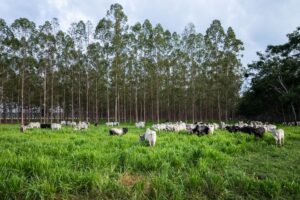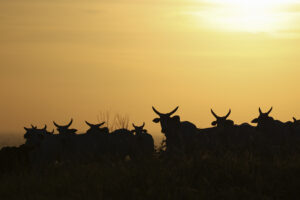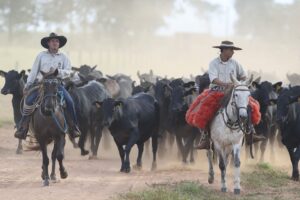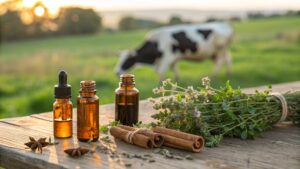
Can COP30 change the future of cows and climate in Brazil?
At COP30, the world’s eyes are on Brazil, and the cattle ranchers leading a global transformation.
They’ve been promoted for everything from stress relief to immune support. Now, essential oils are tackling one of their most ambitious roles yet: reducing methane emissions from cattle.
Rich in organic compounds such as phenols, terpenes, aldehydes, ketones and esters, essential oils have long been studied for their antimicrobial properties. Today, farmers are leveraging those same compounds to target methane-producing microbes in the rumen, and with promising results. This adoption of essential oils is not based on anecdotes or holistic traditions, but on the growing body of scientific research that validates their use.
So, if you’ve never thought of essential oils as part of a climate strategy, consider this: Agriculture is already testing tools most wouldn’t expect.
Let’s unpack the science of methane production from cows, and how essential oils can help reduce it.

Methane, a greenhouse gas roughly 25 to 28 times more potent than carbon dioxide in the near term, is a major byproduct of cattle digestion. As global pressure mounts to curb agricultural emissions, enteric methane (the kind that cows produce through fermentation in the rumen) has become a focal point for both scientists and producers. Though cows contribute only 5–7% of all greenhouse gas emissions, farmers worldwide are committed to reducing this environmental impact wherever possible.
Reducing enteric methane emissions starts not in the atmosphere, but inside the cow.
To understand how essential oils work as a solution, we first have to understand where methane comes from and why cows produce it. A natural byproduct of digestion in ruminants, methane is created when specific groups of microbes in the rumen break down complex carbohydrates, such as fibrous plant matter, and release hydrogen. To keep digestion stable, these specialized microbes then convert any excess hydrogen into methane, which cows release by belching.
Essential oils can selectively target certain microbes, especially methane-producing bacteria and protozoa, without harming the beneficial bacteria that break down fiber. This shifts the fermentation process, often boosting the production of propionate, a volatile fatty acid that uses up hydrogen instead of letting it turn into methane. As a result, methane emissions drop significantly, while cows maintain healthy digestion and performance.
Rather than being added directly or topically (as they typically are in humans), essential oils for cattle are formulated into stable feed additives that are incorporated within the animal’s diet.
Just as specific essential oils are used for different purposes in humans, certain essential oils serve specific purposes in cows. Here’s how some common oils and compounds target methane in the rumen, according to research:
Thyme (thymol): Disrupts methane-producing microbes and protozoa, leading to reduced methane and more propionate.
Oregano (carvacrol): Also inhibits methane-producing microbes and protozoa to lower methane and increase propionate.
Clove (eugenol): Suppresses hydrogen-producing bacteria, stemming the fuel source for methanogenesis without harming digestion.
Cinnamon (cinnamaldehyde): Alters rumen fermentation patterns to favor energy-rich propionate over methane production.
Garlic (allicin): Broadly antimicrobial, garlic oil reduces methanogens and protozoa, often resulting in significant in vitro methane suppression.

Research has shown that in combination, essential oils can have an even greater impact. A recent meta-analysis of trials involving dairy cows supplemented with a commercial essential oil blend reported consistent methane reductions of 10–15%, alongside improvements in milk yield and feed efficiency.
Essential oils also offer a suite of potential benefits for health and performance. For example, optimizing rumen fermentation and reducing methane-producing microbes increases available energy in cows. Certain oils also act as natural antibiotics, fighting harmful bacteria like E. coli while supporting gut health. The antioxidant properties of essential oils may boost immunity during stressful periods, and some varieties even help reduce the risk of bloat.
Also, when animals are healthier, they grow more efficiently, reach market weight faster and may produce more milk per unit of feed. This efficiency translates to lower methane emissions per kilogram of meat or liter of milk produced (a metric known as emissions intensity).
One of the biggest advantages of essential oils is how broadly they can be used. Effective in both pasture-based and barn-fed systems, they can easily be added to feed (including total mixed ration), mineral blocks or even drinking water.
And, with advances in encapsulation technology, essential oil technologies are even more effective than earlier formulations that lacked protection against heat, pH and enzymatic breakdown in the digestive tract. Encapsulation ensures controlled release in the rumen, which improves bioavailability, reduces degradation and enhances consistency of effect compared to non-encapsulated essential oils, especially in TMR or pelleted feeds. This not only boosts the oils’ stability during storage and digestion, but also lowers costs over time.
As agriculture continues to look to smarter, more sustainable practices, essential oils are one of many promising interventions. And while they are in no way a substitute for broader action, they are a meaningful step toward a world in which cattle aren’t part of the problem, but part of the solution.
Request a screening of World Without Cows to spark new conversations about the science, innovations and realities shaping the future of our global food system.

At COP30, the world’s eyes are on Brazil, and the cattle ranchers leading a global transformation.

Restoring 40 million hectares of pasture could feed billions and ease pressure on the Amazon. Is the world paying attention?

New mini-doc explores deforestation, food security and the Brazilian cattle sector’s path to a more sustainable future

Mention Brazilian beef, and you’re likely to spark discussion about familiar themes: deforestation, emissions and blame. What do we find when we dig deeper? Here are the answers to five top questions about Brazil’s role in protecting the Amazon and feeding the world.

From science to the big screen: Discover how a single question grew into a global journey.

The role of essential oils like thyme, oregano and clove in reducing methane emissions from cattle.
As climate change intensifies and the world’s population continues to grow, the pressure on our global food production system mounts. You can play an active role in shaping a more sustainable planet for future generations. Fill out the form below to learn more about how you can partner with us.
Receive notifications about the release date, new online content and how you can get involved